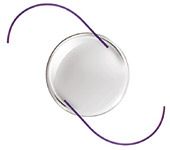Article
Violet-filtering IOLs: Wavelength of the future?
A violet light-filtering IOL seems to protect eyes from phototoxicity caused by ultraviolet light without decreasing nighttime vision or compromising color vision compared with blue light-filtering lenses.

Key Points

The three-piece silicone IOL has prolate aspheric anterior and posterior surfaces with no inherent spherical aberration (SA) and is the first lens of its kind to absorb UV and violet light. "The aberration-free design reduces postoperative SA and prevents decentration from inducing other aberrations," said David R. Chow, MD, FRCSC, assistant professor, Department of Ophthalmology & Visual Sciences, University of Toronto. The lens, he added, "blocks more violet light, . . . better absorbs harmful violet light, and transmits more blue light, which is essential for low-light vision and circadian photoentrainment," compared with a conventional UV-blocking IOL (AcrySof Natural, Alcon Laboratories).
Both Dr. Chow and Louis D. "Skip" Nichamin, MD, who is in private practice at the Laurel Eye Clinic, Brookville, PA, said they believe that the violet light-filtering technology, compared with the blue light-filtering approach, "is a more logical addition to the UV filtration already incorporated in today's conventional IOLs. The entry of violet light into the eye is more likely to cause oxidative stress by producing oxygen reactive species, which have been associated with age-related macular degeneration [AMD]. On the other hand, violet light does not affect vision as blue light does."

Another disadvantage of blue-filtering IOLs, they said, is that they may impair nighttime vision by filtering blue light, to which the rods are sensitive; in addition, they said, blue-filtering IOLs can change patients' color perception and filter the blue light that is needed to regulate circadian rhythms.
The importance of filtering violet wavelengths is underscored, Drs. Chow and Nichamin said, when the accumulation of lipofuscin and the substantial increase in retinal illuminance after cataract surgery is considered. When the natural crystalline lens is removed, the retinas of pseudophakic patients "may be at an increased risk of AMD development. Increased exposure to visible light has been correlated strongly with cataract formation and, to a lesser degree, with the occurrence of AMD."
An analysis of more than 6,000 patients in the Beaver Dam Eye Study and the Blue Mountains Eye Study showed an elevated risk of the development of late-stage AMD 5 years after cataract surgery, they said.
When the natural crystalline lens is replaced with a lens that filters only UV light, the amount of light absorbed by A2E, a toxic fluorophore in the lipofuscin in stressed retinal pigment epithelial cells that has the highest level of absorbance in the violet part of the spectrum, increases by a factor of five.
Newsletter
Don’t miss out—get Ophthalmology Times updates on the latest clinical advancements and expert interviews, straight to your inbox.




